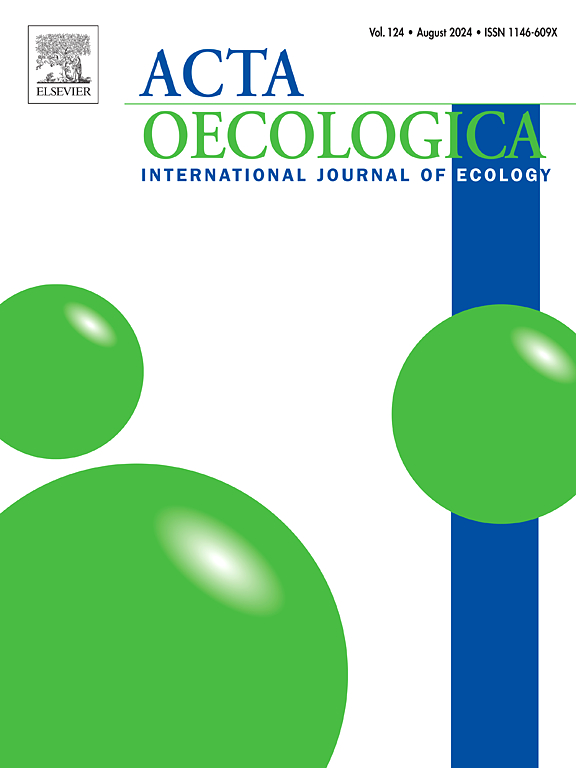乌干达西南部人为白蚁丘侵蚀:时空分布、生物物理特征和农民感知
IF 1.3
4区 环境科学与生态学
Q3 ECOLOGY
Acta Oecologica-International Journal of Ecology
Pub Date : 2025-04-25
DOI:10.1016/j.actao.2025.104078
引用次数: 0
摘要
白蚁丘的存在与人类活动之间的紧张关系无处不在。但白蚁丘生态,侵蚀和相关的人类认知仍然知之甚少。在本文中,我们报告了白蚁丘在乌干达西南部Rwizi流域的时空分布和生物物理特征,以及人类对白蚁丘在种植和牲畜牧场(农业用地)、城郊和原始(国家公园)生态系统中的存在的感知。在5年(2016-2020年)的时间里,我们绘制了谷歌地球(GE)图像中可探测到的20,000个土丘,面积约为。1411平方公里,并详细描述了328个土丘:我们收集了1968个白蚁,400个植被和432个土壤样本。我们还采访了104名农民,以了解他们对白蚁丘的(不同)看法。我们的数据显示,在国家公园的站点有明显更大的(p <;与农业和建成区相比,平均土丘覆盖面积(m2)为:基鲁胡拉(国家公园区)(9042±1874a)、伊辛吉罗(放牧和种植区)(3907±2648b)和姆巴拉拉(城市和城郊)(3687±1081b)。生物物理分析强化了这样一个事实,即白蚁丘是资源稀缺环境中营养和植被丰富的“岛屿”。大白蚁(Macrotermes bellicosus)是最优势的白蚁种,丘状呈空间聚集状(Moran’s I: 0.4 ~ 0.96, p <;0.05),但在时间上存在差异。大多数农民(71.2%)报告说,他们摧毁了农场上的白蚁丘,因为他们认为白蚁具有破坏性,特别是在农业牧场和定居点建设方面。白蚁丘侵蚀与农民的文化程度、年龄和性别相关(χ2 = 11.605, p = 0.001)。尽管如此,农民认为白蚁丘支持蘑菇生长(68.0%),其次是alates(45.6%)是最重要的效益。然而,在农民看来,缺乏生态效益(如养分循环)。提高农民对白蚁丘生态重要性的认识,可以在资源贫乏的环境中更好地决策和平衡白蚁丘的侵蚀与保护。本文章由计算机程序翻译,如有差异,请以英文原文为准。
Anthropogenic termite mound erosion: Spatio-temporal distribution, biophysical characteristics and farmers’ perceptions in SW Uganda
Tension between termite mound existence and human activities is pervasive. But termite mound ecology, erosion and associated human perceptions remain poorly understood. In this paper, we report on the spatio-temporal distribution and biophysical characteristics of termite mounds in the Rwizi catchment in SW-Uganda, and associated human perceptions towards their presence in cropping and livestock ranches (agricultural land), peri-urban and pristine (national Park) ecosystems using a cross-sectional survey in combination with remote sensing and GIS. We mapped >20,000 mounds detectable in Google Earth (GE) imagery over a period of 5 years (2016–2020) in an area approx. 1411 km2, and characterized 328 mounds in detail: we collected 1968 termite-, >400 vegetation- and 432 soil samples. We also interviewed 104 farmers to capture their (varied) perceptions on termite mounds. Our data show that sites in the national park had a significantly larger (p < 0.05) mean area (m2) coverage of mounds compared to the agricultural and built up areas: Kiruhura (9042 ± 1874a) (national park region), Isingiro (3907 ± 2648b) (grazing and cropping region) and Mbarara (3687 ± 1081b) (urban and peri-urban area) respectively. Biophysical analyses reinforce the fact that the termite mounds are ‘islands’ of nutrient and vegetation abundance in resource–scarce environments. Macrotermes bellicosus was the most dominant termite species, and mounds were spatially clustered (Moran's I: 0.4–0.96, p < 0.05) but temporally varied. The majority of farmers (71.2 %) reported that they destroy termite mounds on their farms due to the perceived destructive nature of termites, especially with respect to agricultural pasture and settlement constructions. Termite mound erosion was however associated with education level, age and gender of farmers (χ2 = 11.605, p = 0.001). Nonetheless, farmers perceived that termite mounds support mushroom growth (68.0 %) followed by alates (45.6 %) as the most important benefits. Ecological benefits (e.g., nutrient recycling) are lacking from farmers' views however. Improving farmer knowledge on the ecological importance of the termite mounds could better decision making and a balance between termite mound erosion and conservation in resource-poor environments.
求助全文
通过发布文献求助,成功后即可免费获取论文全文。
去求助
来源期刊
CiteScore
3.60
自引率
0.00%
发文量
57
审稿时长
>0 weeks
期刊介绍:
Acta Oecologica is venue for the publication of original research articles in ecology. We encourage studies in all areas of ecology, including ecosystem ecology, community ecology, population ecology, conservation ecology and evolutionary ecology. There is no bias with respect to taxon, biome or geographic area. Both theoretical and empirical papers are welcome, but combinations are particularly sought. Priority is given to papers based on explicitly stated hypotheses. Acta Oecologica also accepts review papers.

 求助内容:
求助内容: 应助结果提醒方式:
应助结果提醒方式:


